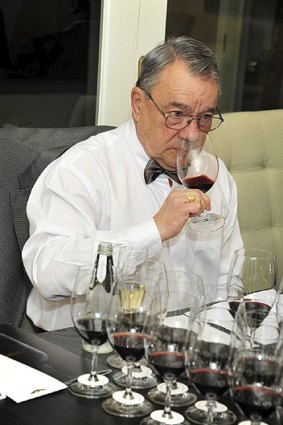This was published 12 years ago
It's not all black and right
Producing great reds is a fickle business, even for the big labels, writes Jeni Port.
By Jeni Port
DO WINE companies release wines with which they are not happy? They do. They may not admit it at the time but with hindsight mistakes can become all too obvious - it is hard to avoid them. They are in the glass and on your tongue, a sharp whiff of soy sauce, a muddiness of flavour with no discernible fruit and a finale of biting tannins.
That's the 1989 Wolf Blass Black Label and Wolf Blass chief winemaker Chris Hatcher now admits the blend of cabernet sauvignon, shiraz and merlot from Langhorne Creek is a major disappointment: ''We should never have bottled this year [1989].''

A reflective Wolf Blass admits to some hits and some misses.
Retrospection at a retrospective wine tasting - in this case 35 years of Wolf Blass Black Label - is generally not quite so brutal.
Of the years 1993-'97, a period he refers to as a ''dark time'' after Wolf Blass Wines had merged with Mildara, Hatcher admits to a divergence in style for Black Label. The '94 is heavy with American oak, the '95 is lean, '96 is ''tough on the palate'', while '97 is only ''starting to get flavour''. ''They are good wines, not great,'' he says.
His boss, Wolf Blass, is equally blunt: ''We had a different winemaker I didn't agree with.''
Was this a tasting or a confessional? It sounded like two guys bagging the boss over coffee in the staff canteen - except they were the bosses. Hatcher has been with Wolf Blass Wines for 24 years. Wolf, of course, was there at the beginning, in 1966.
In 1973, with a $2000 loan and 1.6 hectares of land in the Barossa Valley and a tin shed, he made the first Black Label from ''imported'' fruit, a blend of 80 per cent cabernet sauvignon from Langhorne Creek and 20 per cent shiraz from the Eden Valley. The next year, the wine won the Jimmy Watson Trophy at the Melbourne Wine Show for the best year-old red.
Blass then changed the blend a little, introducing 20 per cent of shiraz from Coonawarra, and won the 1975 Jimmy Watson Trophy.
That year brought another change - this time 20 per cent of Barossa Valley shiraz was blended with Langhorne Creek cabernet - and garnered the same result at the Melbourne Wine Show.
Three vintages, three Jimmy Watsons - it was the stuff of legends.
Wolf Blass has been criticised for many things, some of them well deserved, but it is difficult to understand the attack from Australian winemakers following Blass's Jimmy Watson wins. He was branded as just a blender, as if blending was somehow a lesser tool in the winemaker's work bag.
''We were crucified for 15 years,'' Blass says.
The Jimmy Watson trio cellared well and, given some air, are all in remarkably good shape today. That's despite 1974 being one of the most difficult vintages in recent memory, after 2011.
Blass's pursuit of gold medals has been all-consuming. He demands wine-show ''cutlery'' for his cabinets. Hatcher was told on his first day on the job: no gold medals, no job. Salaries at Wolf Blass Wines were tied to wine-show success but such a single-minded philosophy did take the company and Black Label on a bit of a merry waltz through the '80s and '90s. First, Wolf Blass (like many others) succumbed to the lean and green era in show judging that celebrated skinny wines made from grapes that had been picked early. With cabernet sauvignon playing such a significant role in the Black Label blend, we see some aggressive herbals and pronounced acidity to the fore in wines of the '80s.
Then there was the wine judges' love affair with American oak. It's fair to say Wolf Blass Wines was slower than most in moving away from a reliance on such an overpowering, all-consuming oak. That was the 1990s for you.
The year 1998 denotes the start of the new era of Black Label, a time when Hatcher called on Caroline Dunn to work some magic. That vintage had the first French oak used in Black Label, just 6 per cent, but it was pulse-racing at the time. It also had the highest percentage of cabernet (89 per cent) used in Black Label and a move away from Langhorne Creek as the main source of cabernet and the rise of Barossa cabernet. To Hatcher it is the archetypal, essential Black Label. ''The '98 is plush and long; what Black Label is all about,'' he says.
What he doesn't say is it's also a massive black wine that even moves slowly when you swirl the glass. When it finally comes around, gets itself together, it might be all too late for some of us.
The noughties have French oak as the dominant force in the blend - and some experimentation - with shiraz taking a starring role in 2001 and 2002, and the addition of malbec to the blend from 2002. Why the fiddling? Black Label is, and always will be, a blended red made to a style, not a formula.